
- Constellation: Pegasus
- Right Ascension: 21h 29m 58.33s
- Declination: +12° 10′ 01.2″
- Distance: 33,600 ly
M15 is a globular cluster located in the constellation of Pegasus. It consists of an estimated 100,000 stars and has a very dense central core having undergoing a core collapse where stars migrate towards the center. It's age is estimated at 12 billion years and is located 33,600 light years away.
Cataloged by Charles Messier in 1764 in his catalog of comet like objects.
- Details
- Category: Globular Clusters
- Telescope: Explore Scientific 127 Refractor
- Camera: Atik 314l+
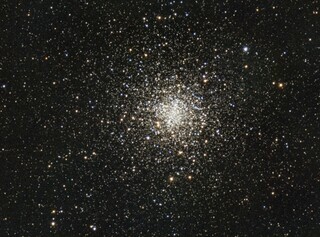
- Constellation: Scorpius
- Right Ascension: 16h 23m 35.22s
- Declination: –26° 31′ 32.7″
- Distance: 7,200 ly
M4 is one of the closer globular clusters to Earth at only 7,200 light years away. Located in the constellation of Scorpius, not far from the red super giant star Antares. It is distinguished by an optical bar of stars running through the central part of the core. A relative small globular as globular clusters go with only ten's of thousands stars, it may have been more massive in its past as it's orbit takes it through the Milky Way disk, where it loses stars due to tidal shock.
- Details
- Category: Globular Clusters
- Telescope: Explore Scientific 127 Refractor
- Camera: Atik 314l+
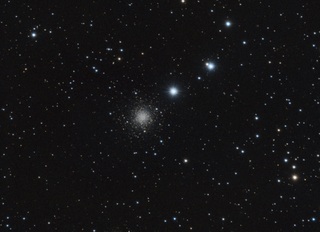
- Constellation: Lynx
- Right Ascension: 07h 38m 08.51s
- Declination: +38° 52′ 54.9″
- Distance: 300,000 from galactic center
Nicknamed the Intergalactic Wanderer because it was originally thought not to be in orbit around the Milky Way galaxy. The globular cluster is located 300,000 light years the galactic center, which is further away than the Large and Small Magellanic satellite galaxies of the Milky Way galaxy. If not for the extreme distance, it would be one of the larger, brightest globular clusters visible. It is estimated it takes 3 billion years to complete an orbit around our galaxy.
- Details
- Category: Globular Clusters
- Telescope: Explore Scientific 127 Refractor
- Camera: Atik 314l+
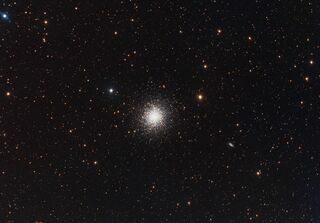
- Constellation: Hercules
- Right Ascension: 16h 41m 41.24s
- Declination: +36° 27′ 35.5″
- Distance: 22,200 ly
Discovered by Edmond Halley in 1714, and added to the Messier catalog by Charles Messier in 1764. It is one of the best know and brightest globular clusters visible in the northern hemisphere.
The cluster contains an estimated 300,000 stars stretching across a diameter of 145 light years. Globular clusters tend to be quite old objects with their stars containing very little of the metal elements.
- Details
- Category: Globular Clusters
- Telescope: EDT 80mm Reftactor
- Camera: ZWO 1600 MM
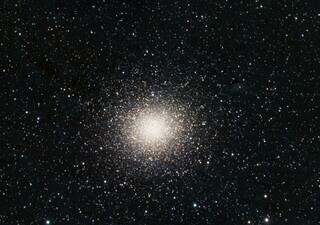
- Constellation: Centaurus
- Right Ascension: 13h 26m 47.28s
- Declination: −47° 28′ 46.1″
- Distance: 15,800 ly
Omega Centauri appears to be a globular cluster located in the skies of the southern hemisphere. It can be barely visible rising just above the horizon from southern locations in the northern hemisphere. This image was imaged from a remote scope located in Australia where rises high in the night sky. It is one of the biggest and brightest of the globulars associated with the Milky Way galaxy. It is thought however, that it might not be an actual globular cluster, its characteristics resemble a disrupted core of a dwarf galaxy that was disrupted by the Milky Way.
Captured with ITelescope's I13 telescope.
- Details
- Category: Globular Clusters
Celebrated the July 4th holiday by imaging one of the brightest and best known globular cluster visible in the northern hemisphere. M13 contains an estimated 300,000 stars. Often called the Great Globular Cluster in Hercules, it is conveniently located in the constellation of Hercules. The cluster was described by Edmond Hally in 1714, and was added to Charles Messier's catalog on June 1, 1764. In 1974 a radio message was sent in the direction of M13 from the Arecibo radio observatory, but don't expect a reply as it would take 25,000 years to get there, and another 25,000 for a reply. Also by that time, both the cluster and the solar system will have moved due to their orbits around the galaxy. Also globular clusters tend to consist of old stars that have very little metal content to form planets that have metals that we find so useful here on Earth.
Imaged with the RC10 scope and the ZWO 1600 MMC mono camera.
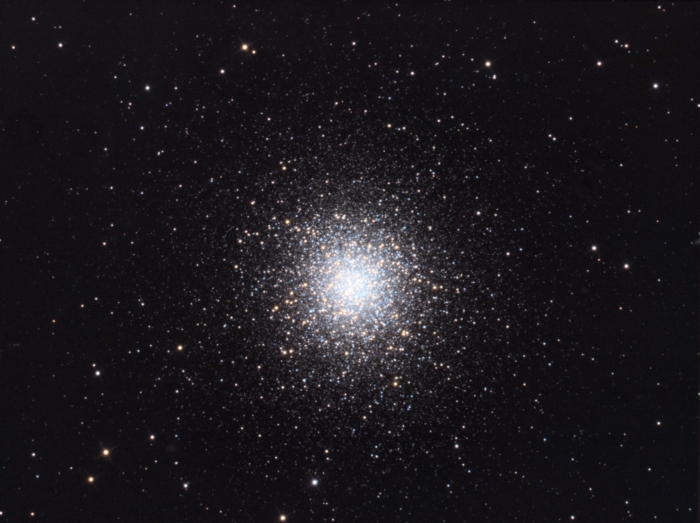
- Details
- Category: Globular Clusters